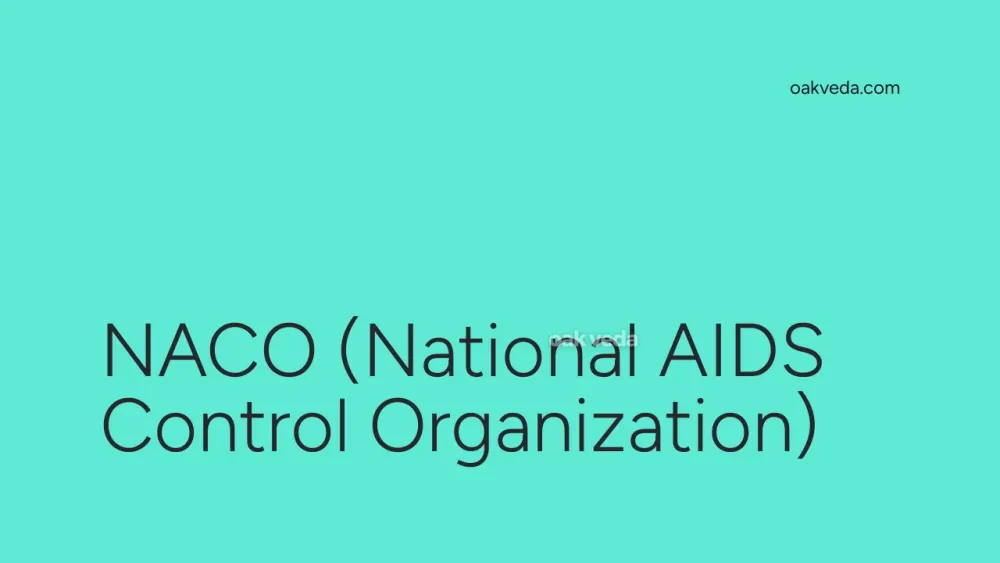
What is the Full Form of NACO?
NACO is the acronym for the National AIDS Control Organization. This government body plays a crucial role in India's fight against HIV/AIDS, operating under the Ministry of Health and Family Welfare.
What is National AIDS Control Organization?
The National AIDS Control Organization (NACO) is a pivotal institution in India's healthcare system, dedicated to monitoring and controlling the HIV/AIDS epidemic. Established with the primary goal of enhancing healthcare coverage for HIV-positive individuals, NACO strives to protect and uphold their human rights while ensuring access to dignified care.
Origin and Development of NACO
NACO was established in 1992 as a response to the growing HIV/AIDS crisis in India. Since its inception, the organization has evolved significantly, adapting to new challenges and incorporating advanced strategies to combat the spread of HIV.
How does NACO work?
NACO operates through a multi-faceted approach:
- Awareness Campaigns: Conducting nationwide programs to educate the public about HIV/AIDS.
- Healthcare Services: Providing comprehensive medical care to HIV-positive individuals.
- Research and Surveillance: Monitoring HIV trends and conducting studies to inform policy decisions.
- Partnerships: Collaborating with NGOs, community organizations, and international bodies.
Functions of NACO
The primary functions of NACO include:
- Formulating policies and strategies for HIV/AIDS control
- Implementing prevention and treatment programs
- Coordinating with various stakeholders in the fight against HIV/AIDS
- Promoting safe behavioral practices to reduce HIV transmission
- Ensuring access to antiretroviral therapy (ART) for those in need
Applications of NACO's Initiatives
NACO's work has wide-ranging applications:
- Healthcare Delivery: Improving access to HIV testing, counseling, and treatment services.
- Social Impact: Reducing stigma and discrimination associated with HIV/AIDS.
- Economic Benefits: Mitigating the economic burden of HIV/AIDS on individuals and the nation.
- Research Advancement: Contributing to global knowledge on HIV/AIDS management.
Features of NACO's Approach
NACO's approach is characterized by:
- Comprehensive Coverage: Addressing all aspects of HIV/AIDS control, from prevention to treatment.
- Evidence-Based Strategies: Utilizing scientific research to inform policies and programs.
- Community Engagement: Involving local communities in HIV/AIDS control efforts.
- Integration with Healthcare System: Aligning HIV/AIDS services with the broader healthcare infrastructure.
Benefits of NACO's Initiatives
The benefits of NACO's work are far-reaching:
- Reduced HIV Prevalence: Significant decline in new HIV infections since NACO's establishment.
- Improved Quality of Life: Enhanced healthcare and support for HIV-positive individuals.
- Increased Awareness: Greater public understanding of HIV/AIDS and prevention methods.
- Strengthened Healthcare System: Improved capacity to handle infectious diseases beyond HIV/AIDS.
Limitations or Challenges Faced by NACO
Despite its successes, NACO faces several challenges:
- Resource Constraints: Limited funding and human resources to cover a vast population.
- Stigma and Discrimination: Persistent social barriers affecting HIV/AIDS control efforts.
- Reaching High-Risk Groups: Difficulties in accessing and educating vulnerable populations.
- Ensuring Treatment Adherence: Challenges in maintaining long-term adherence to antiretroviral therapy.
Future Developments in NACO's Strategies
Looking ahead, NACO is focusing on:
- Digital Health Interventions: Leveraging technology for better outreach and service delivery.
- Precision Public Health: Tailoring interventions based on regional and demographic data.
- Integration with SDGs: Aligning HIV/AIDS control efforts with Sustainable Development Goals.
- Innovative Partnerships: Exploring new collaborations with private sector and international organizations.
FAQs on NACO Full Form
-
What does NACO stand for? NACO stands for National AIDS Control Organization.
-
When was NACO established? NACO was established in 1992.
-
What is the primary goal of NACO? The primary goal of NACO is to control the spread of HIV/AIDS in India and provide comprehensive care to affected individuals.
-
How does NACO work with other organizations? NACO collaborates with NGOs, women's self-help groups, and other support networks to ensure comprehensive HIV/AIDS control efforts.
-
What are some key achievements of NACO? NACO has significantly reduced new HIV infections, improved access to antiretroviral therapy, and increased awareness about HIV/AIDS prevention.
In conclusion, the National AIDS Control Organization (NACO) has been at the forefront of India's fight against HIV/AIDS for nearly three decades. Through its comprehensive approach, NACO has made significant strides in controlling the epidemic, improving the lives of those affected, and raising awareness about HIV/AIDS. As it continues to evolve and adapt to new challenges, NACO remains a crucial player in India's public health landscape, working tirelessly towards its vision of an AIDS-free India.
You may be interested in:
- NPCI (National Payments Corporation of India)
- GST (Goods and Services Tax): Full Form and Explained
- NTG (Nitroglycerin): Full Form and Medical Uses
- OCD (Obsessive Compulsive Disorder): Full Form
- B.Tech (Bachelor of Technology): Full Form Explained
- TGB (Telangana Grameena Bank): Full Form and Overview

